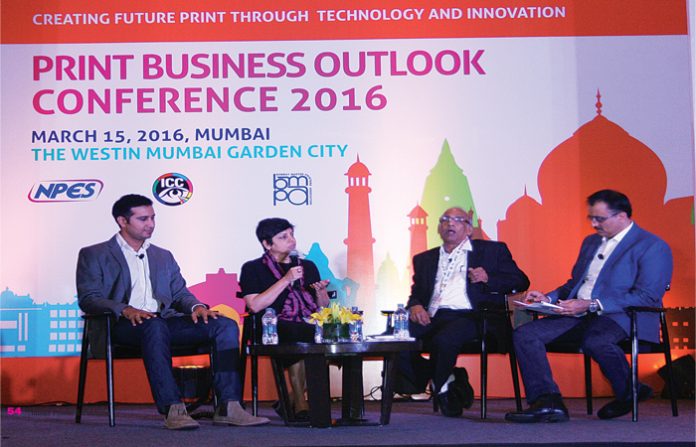
Mumbai’s Westin Hotel was the venue for the power packed Print Business Outlook Conference 2016 organized by NPES, ICC and BMPA. Held on 15 March, the day long event saw talks by leading experts from the world of color management, digital print and branding and packaging design. The first half of the day primarily discussed color management. William Li, ICC co-chair and color technology manager, Kodak, presented ‘Color Management in the Post-Digital Age.’ Phil Green, professor of color imaging at NTNU in Gjøvik, Norway talked about the open source tools of iccMAX, while Steve Smiley of Smiley Color & Associates Global Brand Solutions, spoke on the management of special and brand colors. Elie Khoury, president of Alwan Color Expertise, discussed ways to build an ISO and ICC compliant workflow.
V Balakrishnan, executive general manager, Konica Minolta India and Appadurai, country manager – Indigo and Inkjet Solutions, HewlettPackard India, informed the audience about opportunities that can be explored through digital printing. Appadurai showed a short film demonstrating of Pragati’s recent variable design carton project for an FMCG company that demonstrated that digital packaging was not just something for the west but something that is being done in India today and which seems to have caught the imagination of some brand owners and designers. The latter half of the day saw the focus shift to packaging design and branding. Ashwini Deshpande, founder-director, Elephant, and Abhimanyu Nohwar, founder-director, Kiba Design, delved into various aspects of design and future trends.
Deshpande in her presentation said that one of the most important trends being witnessed is that customers are now increasingly demanding fresh food and packaging designers would now have to keep this aspect in mind. Another pertinent point she raised was that of increasing penetration of internet in the lives of Indians. “The internet of things, smart applications and augmented reality are some aspects that designers have to be ready for,” she stated.
Environment safety, Deshpande said, would be another challenging theme for packaging designers. Per capita packaging consumption in India, according to estimates, is around 4.3 kg. This provides ample room for growth in consumption of packaging. However, according to Deshpande, along with contributing to increase in consumption of packaging volume, designers also need to make sure that the value derived from packaging also goes up. “We not only need to work towards facilitating the growth in packaging consumption but also need to work towards enhancing the value of the packaging that would be consumed. And in the process we need to come up with responsible solutions.”
Environmental safety was also the underlying theme of Nohwar’s talk. He said that increased packaging consumption in a highly populous nation like India would create tremendous pressure on the environment. However, he felt this challenge could be handled effectively by taking informed decisions by all the stakeholders of the packaging industry. “Informed decisions can be taken when design professionals and packaging professionals sit together for discussions and dialogues. However, at the moment this is not happening. And it needs to change,” Nohwar said.
After the two presentations, a panel discussion moderated by BMPA president Faheem Agboatwala took place. Deshpande and Nohwar were joined by KM Lakshminarayanan, packaging consultant and ex-head of packaging at Colgate India on the panel. However, on Agboatwala’s question of digital printing in packaging, the panelists may have missed the earlier presentation showing a run of variable designs across 10 million cartons. Lakshminarayana said that because of huge volumes in packaging, digital printing will take some more time to be feasible. Deshpande added that digital printing at the moment would make sense for customization or on the spot packaging which is becoming popular in the West such as in the juice packaging that she showed in her presentation where the label boldly proclaimed that the juice had been freshly made minutes before being place on the shelf.















